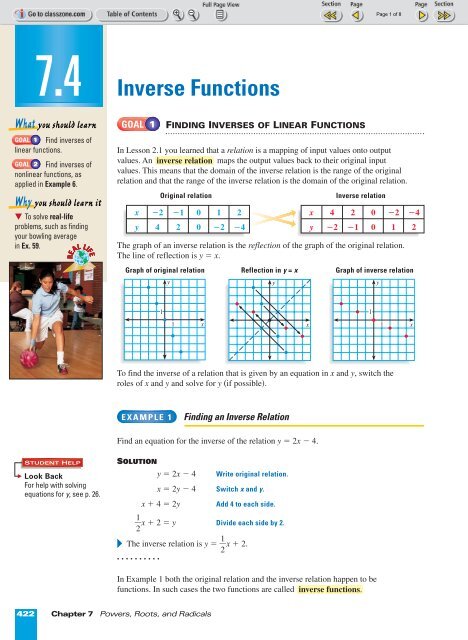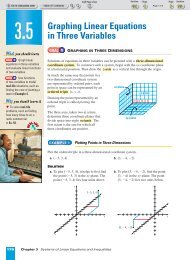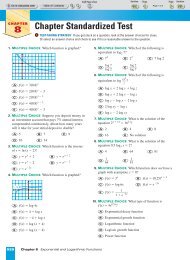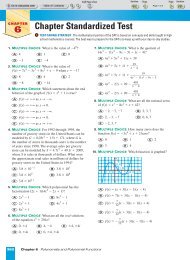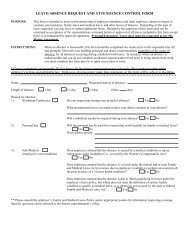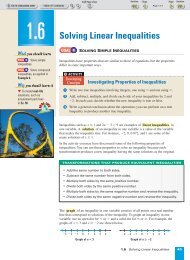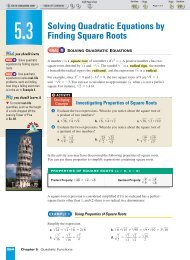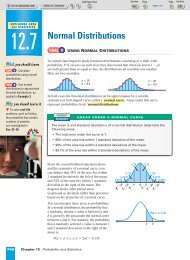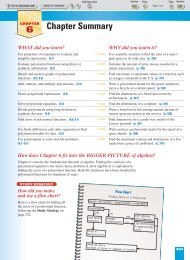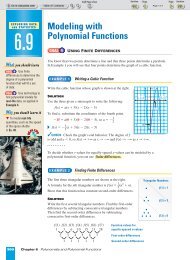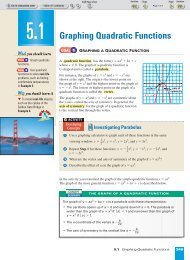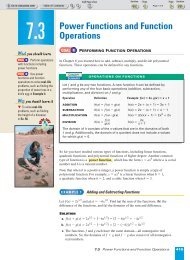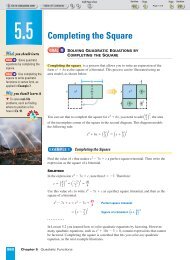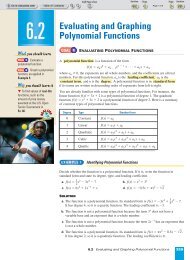Inverse Functions - Beau Chene High School Home Page
Inverse Functions - Beau Chene High School Home Page
Inverse Functions - Beau Chene High School Home Page
Create successful ePaper yourself
Turn your PDF publications into a flip-book with our unique Google optimized e-Paper software.
7.4<br />
<strong>Inverse</strong> <strong>Functions</strong><br />
What you should learn<br />
GOAL 1 Find inverses of<br />
linear functions.<br />
GOAL 2 Find inverses of<br />
nonlinear functions, as<br />
applied in Example 6.<br />
Why you should learn it<br />
To solve real-life<br />
problems, such as finding<br />
your bowling average<br />
in Ex. 59.<br />
REAL<br />
LIFE<br />
GOAL 1<br />
FINDING INVERSES OF LINEAR FUNCTIONS<br />
In Lesson 2.1 you learned that a relation is a mapping of input values onto output<br />
values. An inverse relation maps the output values back to their original input<br />
values. This means that the domain of the inverse relation is the range of the original<br />
relation and that the range of the inverse relation is the domain of the original relation.<br />
Original relation<br />
x º2 º1 0 1 2<br />
y 4 2 0 º2 º4<br />
<strong>Inverse</strong> relation<br />
x 4 2 0 º2 º4<br />
y º2 º1 0 1 2<br />
The graph of an inverse relation is the reflection of the graph of the original relation.<br />
The line of reflection is y = x.<br />
Graph of original relation Reflection in y = x Graph of inverse relation<br />
y<br />
y<br />
y<br />
1<br />
1 x<br />
x<br />
1<br />
1 x<br />
To find the inverse of a relation that is given by an equation in x and y, switch the<br />
roles of x and y and solve for y (if possible).<br />
EXAMPLE 1<br />
Finding an <strong>Inverse</strong> Relation<br />
Find an equation for the inverse of the relation y = 2x º 4.<br />
STUDENT HELP<br />
Look Back<br />
For help with solving<br />
equations for y, see p. 26.<br />
SOLUTION<br />
y = 2x º 4 Write original relation.<br />
x = 2y º 4 Switch x and y.<br />
x + 4 = 2y<br />
Add 4 to each side.<br />
1 x + 2 = y Divide each side by 2.<br />
2<br />
The inverse relation is y = 1 x + 2.<br />
2<br />
. . . . . . . . . .<br />
In Example 1 both the original relation and the inverse relation happen to be<br />
functions. In such cases the two functions are called inverse functions.<br />
422 Chapter 7 Powers, Roots, and Radicals
STUDENT HELP<br />
Study Tip<br />
The notation for an<br />
inverse function, ƒ º1 ,<br />
looks like a negative<br />
exponent, but it should<br />
not be interpreted that<br />
way. In other words,<br />
ƒ º1 (x) ≠ (ƒ(x)) º1 1<br />
= ƒ(x)<br />
.<br />
INVERSE FUNCTIONS<br />
<strong>Functions</strong> ƒ and g are inverses of each other provided:<br />
ƒ(g(x)) = x and g(ƒ(x)) = x<br />
The function g is denoted by ƒ º1 , read as “ƒ inverse.”<br />
Given any function, you can always find its inverse relation by switching x and y. For<br />
a linear function ƒ(x)=mx + b where m ≠ 0, the inverse is itself a linear function.<br />
EXAMPLE 2<br />
Verifying <strong>Inverse</strong> <strong>Functions</strong><br />
Verify that ƒ(x) = 2x º 4 and ƒ º1 (x) = 1 x + 2 are inverses.<br />
2<br />
SOLUTION Show that ƒ(ƒ º1 (x)) = x and ƒ º1 (ƒ(x)) = x.<br />
ƒ(ƒ º1 (x)) = ƒ 1 2 x + 2 ƒ º1 (ƒ(x)) = ƒ º1 (2x º 4)<br />
= 2 1 <br />
2 x + 2 º 4 = 1 (2x º 4) + 2<br />
2<br />
= x + 4 º 4 = x º 2 + 2<br />
= x ✓ = x ✓<br />
REAL<br />
LIFE<br />
EXAMPLE 3<br />
Writing an <strong>Inverse</strong> Model<br />
STUDENT HELP<br />
Science<br />
Study Tip<br />
Notice that you do not<br />
switch the variables<br />
when you are finding<br />
inverses for models. This<br />
would be confusing<br />
because the letters are<br />
chosen to remind you of<br />
the real-life quantities<br />
they represent.<br />
When calibrating a spring scale, you need to know how far<br />
the spring stretches based on given weights. Hooke’s law<br />
states that the length a spring stretches is proportional to<br />
the weight attached to the spring. A model for one scale<br />
is ¬ = 0.5w + 3 where ¬ is the total length (in inches) of<br />
the spring and w is the weight (in pounds) of the object.<br />
a. Find the inverse model for the scale.<br />
b. If you place a melon on the scale and the spring<br />
stretches to a total length of 5.5 inches, how much<br />
does the melon weigh?<br />
SOLUTION<br />
a. ¬ = 0.5w + 3 Write original model.<br />
¬ º 3 = 0.5w Subtract 3 from each side.<br />
¬ º 3<br />
= w Divide each side by 0.5.<br />
0.5<br />
2¬ º 6 = w Simplify.<br />
b. To find the weight of the melon, substitute 5.5 for ¬.<br />
w = 2¬ º 6 = 2(5.5) º 6 = 11 º 6 = 5<br />
The melon weighs 5 pounds.<br />
unweighted<br />
spring<br />
3<br />
0.5w<br />
Not drawn to scale<br />
spring with<br />
weight<br />
attached<br />
l<br />
7.4 <strong>Inverse</strong> <strong>Functions</strong> 423
GOAL 2<br />
FINDING INVERSES OF NONLINEAR FUNCTIONS<br />
The graphs of the power functions ƒ(x) = x 2 and g(x) = x 3 are shown below along<br />
with their reflections in the line y = x. Notice that the inverse of g(x) = x 3 is a<br />
function, but that the inverse of ƒ(x) = x 2 is not a function.<br />
STUDENT HELP<br />
y<br />
y<br />
Look Back<br />
For help with recognizing<br />
when a relationship is a<br />
function, see p. 70.<br />
ƒ(x) x 2 x y 2<br />
2<br />
2<br />
x<br />
g 1 3<br />
(x) x<br />
1<br />
1<br />
g(x) x 3<br />
x<br />
If the domain of ƒ(x) = x 2 is restricted, say to only nonnegative real numbers, then<br />
the inverse of ƒ is a function.<br />
EXAMPLE 4<br />
Finding an <strong>Inverse</strong> Power Function<br />
Find the inverse of the function ƒ(x) = x 2 , x ≥ 0.<br />
SOLUTION<br />
ƒ(x) = x 2<br />
Write original function.<br />
y = x 2 Replace ƒ(x) with y.<br />
x = y 2 Switch x and y.<br />
x = y<br />
Take square roots of each side.<br />
Because the domain of ƒ is restricted to nonnegative values,<br />
the inverse function is ƒ º1 (x)=x. (You would choose<br />
ƒ º1 (x) = ºxif the domain had been restricted to x ≤ 0.)<br />
y<br />
ƒ(x) x 2<br />
x ≥ 0<br />
✓CHECK To check your work, graph ƒ and ƒ º1 as shown.<br />
Note that the graph of ƒ º1 (x) = xis the reflection of<br />
the graph of ƒ(x) = x 2 , x ≥ 0 in the line y = x.<br />
1<br />
1<br />
ƒ 1 (x) x<br />
x<br />
. . . . . . . . . .<br />
In the graphs at the top of the page, notice that the graph of ƒ(x) = x 2 can be<br />
intersected twice with a horizontal line and that its inverse is not a function. On the<br />
other hand, the graph of g(x) = x 3 cannot be intersected twice with a horizontal line<br />
and its inverse is a function. This observation suggests the horizontal line test.<br />
HORIZONTAL LINE TEST<br />
If no horizontal line intersects the graph of a function ƒ more than once, then the<br />
inverse of ƒ is itself a function.<br />
424 Chapter 7 Powers, Roots, and Radicals
EXAMPLE 5<br />
Finding an <strong>Inverse</strong> Function<br />
Consider the function ƒ(x) = 1 2 x3 º 2. Determine whether the inverse of ƒ is a<br />
function. Then find the inverse.<br />
SOLUTION<br />
Begin by graphing the function and noticing that no<br />
horizontal line intersects the graph more than once. This<br />
tells you that the inverse of ƒ is itself a function. To find<br />
an equation for ƒ º1 , complete the following steps.<br />
1<br />
y<br />
1<br />
x<br />
ƒ(x) = 1 2 x3 º 2<br />
Write original function.<br />
y = 1 2 x3 º 2 Replace ƒ(x) with y.<br />
x = 1 2 y3 º 2 Switch x and y.<br />
x + 2 = 1 2 y3<br />
Add 2 to each side.<br />
2x + 4 = y 3 Multiply each side by 2.<br />
3 2x+ 4 = y<br />
Take cube root of each side.<br />
The inverse function is ƒ º1 (x) = 3 2x+ 4.<br />
EXAMPLE 6<br />
Writing an <strong>Inverse</strong> Model<br />
FOCUS ON<br />
APPLICATIONS<br />
ASTRONOMY Near the end of a star’s life the star will eject gas, forming a<br />
planetary nebula. The Ring Nebula is an example of a planetary nebula. The volume<br />
V (in cubic kilometers) of this nebula can be modeled by V = (9.01 ª 10 26 )t 3 where<br />
t is the age (in years) of the nebula. Write the inverse model that gives the age of the<br />
nebula as a function of its volume. Then determine the approximate age of the Ring<br />
Nebula given that its volume is about 1.5 ª 10 38 cubic kilometers.<br />
SOLUTION<br />
3<br />
V<br />
<br />
9.01 ª 10<br />
26<br />
V<br />
= t<br />
9.01 ª 10<br />
26<br />
V = (9.01 ª 10 26 )t 3<br />
Write original model.<br />
= t 3 Isolate power.<br />
Take cube root of each side.<br />
ASTRONOMY<br />
The Ring Nebula is<br />
part of the constellation Lyra.<br />
The radius of the nebula is<br />
expanding at an average rate<br />
of about 5.99 10 8 kilometers<br />
per year.<br />
APPLICATION LINK<br />
www.mcdougallittell.com<br />
REAL<br />
INTERNET<br />
LIFE<br />
(1.04 ª 10 º9 ) 3 V = t Simplify.<br />
To find the age of the nebula, substitute 1.5 ª 10 38 for V.<br />
t = (1.04 ª 10 º9 ) 3 V<br />
Write inverse model.<br />
= (1.04 ª 10 º9 ) 3 1.5 ª 10 38 Substitute for V.<br />
≈ 5500<br />
Use a calculator.<br />
The Ring Nebula is about 5500 years old.<br />
7.4 <strong>Inverse</strong> <strong>Functions</strong> 425
GUIDED PRACTICE<br />
Vocabulary Check ✓<br />
Concept Check ✓<br />
Skill Check ✓<br />
1. Explain how to use the horizontal line test to determine if an inverse relation is<br />
an inverse function.<br />
2. Describe how the graph of a relation and the graph of its inverse are related.<br />
3. Explain the steps in finding an equation for an inverse function.<br />
Find the inverse relation.<br />
4. x 1 2 3 4 5 5.<br />
y º1 º2 º3 º4 º5<br />
x º4 º2 0 2 4<br />
y 2 1 0 1 2<br />
Find an equation for the inverse relation.<br />
6. y = 5x 7. y = 2x º 1 8. y = º 2 3 x + 6<br />
Verify that ƒ and g are inverse functions.<br />
/3<br />
9. ƒ(x) = 8x 3 , g(x) = x1 <br />
2<br />
10. ƒ(x) = 6x + 3, g(x) = 1 6 x º 1 2 <br />
Find the inverse function.<br />
PRACTICE AND APPLICATIONS<br />
11. ƒ(x) = 3x 4 , x ≥ 0 12. ƒ(x) = 2x 3 + 1<br />
13. The graph of ƒ(x) = º|x| + 1 is shown. Is the inverse of<br />
ƒ a function? Explain.<br />
1<br />
y<br />
Ex. 13<br />
3 x<br />
STUDENT HELP<br />
Extra Practice<br />
to help you master<br />
skills is on p. 949.<br />
INVERSE RELATIONS Find the inverse relation.<br />
14. x 1 4 1 0 1 15. x 1 º2 4 2 º2<br />
y 3 º1 6 º3 9<br />
y 0 3 º2 2 º1<br />
FINDING INVERSES Find an equation for the inverse relation.<br />
16. y = º2x + 5 17. y = 3x º 3 18. y = 1 2 x + 6<br />
19. y = º 4 x + 11 20. y = 11x º 5 21. y = º12x + 7<br />
5<br />
22. y = 3x º 1 4 23. y = 8x º 13 24. y = º3 7 x + 5 7 <br />
STUDENT HELP<br />
HOMEWORK HELP<br />
Example 1: Exs. 14–24<br />
Example 2: Exs. 25–32<br />
Example 3: Exs. 57–59<br />
Example 4: Exs. 33–41<br />
Example 5: Exs. 42–56<br />
Example 6: Exs. 60–62<br />
VERIFYING INVERSES Verify that ƒ and g are inverse functions.<br />
25. ƒ(x) = x + 7, g(x) = x º 7 26. ƒ(x) = 3x º 1, g(x) = 1 3 x + 1 <br />
3<br />
27. ƒ(x) = 1 2 x + 1, g(x) = 2x º 2 28. ƒ(x) = º2x + 4, g(x) = º1 2 x + 2<br />
29. ƒ(x) = 3x 3 + 1, g(x) = x 1<br />
3<br />
1/3 30. ƒ(x) = 1 3 x2 , x ≥ 0; g(x) = (3x) 1/2<br />
x<br />
31. ƒ(x) = +2<br />
, g(x) = 5 7xº 2 7<br />
32. ƒ(x) = 256x 4 , x ≥ 0; g(x) = 4 x<br />
4<br />
426 Chapter 7 Powers, Roots, and Radicals
VISUAL THINKING Match the graph with the graph of its inverse.<br />
33. y<br />
34. 35.<br />
3<br />
y<br />
1<br />
1<br />
1<br />
x<br />
1<br />
x<br />
1 x<br />
A. y<br />
B. y<br />
C.<br />
y<br />
1<br />
1<br />
1<br />
1<br />
x<br />
1 x<br />
3 x<br />
INVERSES OF POWER FUNCTIONS Find the inverse power function.<br />
36. ƒ(x) = x 7 37. ƒ(x) = ºx 6 , x ≥ 0 38. ƒ(x) = 3x 4 , x ≤ 0<br />
39. ƒ(x) = 3<br />
12 x5 40. ƒ(x) = 10x 3 41. ƒ(x) = º 9 4 x2 , x ≤ 0<br />
INVERSES OF NONLINEAR FUNCTIONS Find the inverse function.<br />
42. ƒ(x) = x 3 + 2 43. ƒ(x) = º2x 5 + 1 3 44. ƒ(x) = 2 º 2x2 , x ≤ 0<br />
45. ƒ(x) = 3 5 x3 º 9 46. ƒ(x) = x 4 º 1 2 , x ≥ 0 47. ƒ(x) = 1 6 x5 2<br />
+ 3<br />
INVESTMENT<br />
BANKER<br />
Investment bankers have<br />
a wide variety of job<br />
descriptions. Some buy and<br />
sell international currencies<br />
at reported exchange rates,<br />
discussed in Ex. 57.<br />
CAREER LINK<br />
www.mcdougallittell.com<br />
REAL<br />
INTERNET<br />
LIFE<br />
FOCUS ON<br />
CAREERS<br />
HORIZONTAL LINE TEST Graph the function ƒ. Then use the graph to<br />
determine whether the inverse of ƒ is a function.<br />
48. ƒ(x) = º2x + 3 49. ƒ(x) = x + 3 50. ƒ(x) = x 2 + 1<br />
51. ƒ(x) = º3x 2 52. ƒ(x) = x 3 + 3 53. ƒ(x) = 2x 3<br />
54. ƒ(x) = |x| + 2 55. ƒ(x) = (x + 1)(x º 3) 56. ƒ(x) = 6x 4 º 9x + 1<br />
57. EXCHANGE RATE The Federal Reserve Bank of New York reports<br />
international exchange rates at 12:00 noon each day. On January 20, 1999,<br />
the exchange rate for Canada was 1.5226. Therefore, the formula that gives<br />
Canadian dollars in terms of United States dollars on that day is<br />
D C = 1.5226D US<br />
where D C represents Canadian dollars and D US represents United States dollars.<br />
Find the inverse of the function to determine the value of a United States dollar<br />
in terms of Canadian dollars on January 20, 1999.<br />
INTERNET<br />
DATA UPDATE of Federal Reserve Bank of New York data at www.mcdougallittell.com<br />
58. TEMPERATURE CONVERSION The formula to convert temperatures from<br />
degrees Fahrenheit to degrees Celsius is:<br />
C = 5 (F º 32)<br />
9<br />
Write the inverse of the function, which converts temperatures from degrees<br />
Celsius to degrees Fahrenheit. Then find the Fahrenheit temperatures that are<br />
equal to 29°C, 10°C, and 0°C.<br />
7.4 <strong>Inverse</strong> <strong>Functions</strong> 427
STUDENT HELP<br />
HOMEWORK HELP<br />
Visit our Web site<br />
www.mcdougallittell.com<br />
for help with problem<br />
solving in Ex. 62.<br />
INTERNET<br />
Test<br />
Preparation<br />
59. BOWLING In bowling a handicap is a change in score to adjust for<br />
differences in players’ abilities. You belong to a bowling league in which each<br />
bowler’s handicap h is determined by his or her average a using this formula:<br />
h = 0.9(200 º a)<br />
(If the bowler’s average is over 200, the handicap is 0.) Find the inverse of the<br />
function. Then find your average if your handicap is 27.<br />
60. GAMES You and a friend are playing a number-guessing game. You ask<br />
your friend to think of a positive number, square the number, multiply the result<br />
by 2, and then add 3. If your friend’s final answer is 53, what was the original<br />
number chosen? Use an inverse function in your solution.<br />
61. FISH The weight w (in kilograms) of a hake, a<br />
type of fish, is related to its length l (in centimeters)<br />
by this function:<br />
w = (9.37 ª 10 º6 )l 3<br />
Find the inverse of the function. Then determine<br />
the approximate length of a hake that weighs<br />
0.679 kilogram. Source: Fishbyte<br />
62. SHELVES The weight w (in pounds) that can be supported by a shelf made<br />
from half-inch Douglas fir plywood can be modeled by<br />
3<br />
w = 82 .9<br />
d<br />
where d is the distance (in inches) between the supports for the shelf. Find the<br />
inverse of the function. Then find the distance between the supports of a shelf<br />
that can hold a set of encyclopedias weighing 66 pounds.<br />
QUANTITATIVE COMPARISON In Exercises 63 and 64, choose the statement<br />
that is true about the given quantities.<br />
¡ A The quantity in column A is greater.<br />
¡ B The quantity in column B is greater.<br />
Hake<br />
¡ C The two quantities are equal.<br />
¡ D The relationship cannot be determined from the given information.<br />
63.<br />
64.<br />
Column A<br />
Column B<br />
ƒ º1 (3) where ƒ(x) = 6x + 1 ƒ º1 (º4) where ƒ(x) = º2x + 9<br />
ƒ º1 (2) where ƒ(x) = º5x 3 ƒ º1 (0) where ƒ(x) = x 3 + 14<br />
★ Challenge<br />
EXTRA CHALLENGE<br />
www.mcdougallittell.com<br />
INVERSE FUNCTIONS Complete Exercises 65–68 to explore functions that are<br />
their own inverses.<br />
65. VISUAL THINKING The functions ƒ(x) = x and g(x) = ºx are their own<br />
inverses. Graph each function and explain why this is true.<br />
66. Graph other linear functions that are their own inverses.<br />
67. Write equations of the lines you graphed in Exercise 66.<br />
68. Use your equations from Exercise 67 to find a general formula for a family of<br />
linear equations that are their own inverses.<br />
428 Chapter 7 Powers, Roots, and Radicals
MIXED REVIEW<br />
ABSOLUTE VALUE FUNCTIONS Graph the absolute value function.<br />
(Review 2.8 for 7.5)<br />
69. ƒ(x) = |x| º 1 70. ƒ(x) = 2|x| + 7<br />
71. ƒ(x) = |x º 4| + 5 72. ƒ(x) = º3|x + 2| º 7<br />
QUADRATIC FUNCTIONS Graph the quadratic function. (Review 5.1 for 7.5)<br />
73. ƒ(x) = x 2 + 2 74. ƒ(x) = (x + 3) 2 º 7<br />
75. ƒ(x) = 2(x + 2) 2 º 5 76. ƒ(x) = º3(x º 4) 2 + 1<br />
SIMPLIFYING EXPRESSIONS<br />
are positive. (Review 7.2)<br />
Simplify the expression. Assume all variables<br />
77. 4 20 • <br />
4 4 5 78. 1 9 1/6 1 9 1/3 79.<br />
(5y) 1/5<br />
<br />
(5y)<br />
6/5<br />
80. 6 2x 6 81. 3 7 5 + 2 7 5 82. 3 270 + 2 3 10<br />
83. SNACK FOODS Delia, Ruth, and Amy go to the store to buy snacks. Delia<br />
buys 3 bagels and 3 apples. Ruth buys 1 pretzel, 2 bagels, and 3 apples. Amy<br />
buys 2 pretzels and 4 bagels. Delia’s bill comes to $3.72, Ruth’s to $5.06, and<br />
Amy’s to $6.58. How much does one bagel cost? (Review 3.6)<br />
QUIZ 2 Self-Test for Lessons 7.3 and 7.4<br />
Let ƒ(x) = 6x 2 º x 1/2 and g(x) = 2x 1/2 . Perform the indicated operation and<br />
state the domain. (Lesson 7.3)<br />
1. ƒ(x) + g(x) 2. ƒ(x) º g(x) 3. ƒ(x) • g(x) 4. ƒ ( x)<br />
<br />
g(<br />
x)<br />
Let ƒ(x) = 3x º1 and g(x) = x º 8. Perform the indicated operation and state<br />
the domain. (Lesson 7.3)<br />
5. ƒ(g(x)) 6. g(ƒ(x)) 7. ƒ(ƒ(x)) 8. g(g(x))<br />
Verify that ƒ and g are inverse functions. (Lesson 7.4)<br />
9. ƒ(x) = 2x º 3, g(x) = 1 2 x + 3 2 10. ƒ(x) = (x + 1)1/3 , g(x) = x 3 º 1<br />
Find the inverse function. (Lesson 7.4)<br />
11. ƒ(x) = x + 8 12. ƒ(x) = 2x 4 , x ≤ 0 13. ƒ(x) = ºx 5 + 6<br />
Graph the function ƒ. Then use the graph to determine whether the inverse of<br />
ƒ is a function. (Lesson 7.4)<br />
14. ƒ(x) = 3x 6 + 2 15. ƒ(x) = º2x 5 + 3x º 1 16. ƒ(x) = 6 3 x+ 4<br />
17. RIPPLES IN A POND You drop a pebble into a calm pond causing ripples of<br />
concentric circles. The radius r (in feet) of the outer ripple is given by r(t) = 0.6t<br />
where t is the time (in seconds) after the pebble hits the water. The area A (in<br />
square feet) of the outer ripple is given by A(r) = πr 2 . Use composition of functions<br />
to find the relationship between area and time. Then find the area of the outer ripple<br />
after 2 seconds. (Lesson 7.3)<br />
7.4 <strong>Inverse</strong> <strong>Functions</strong> 429


